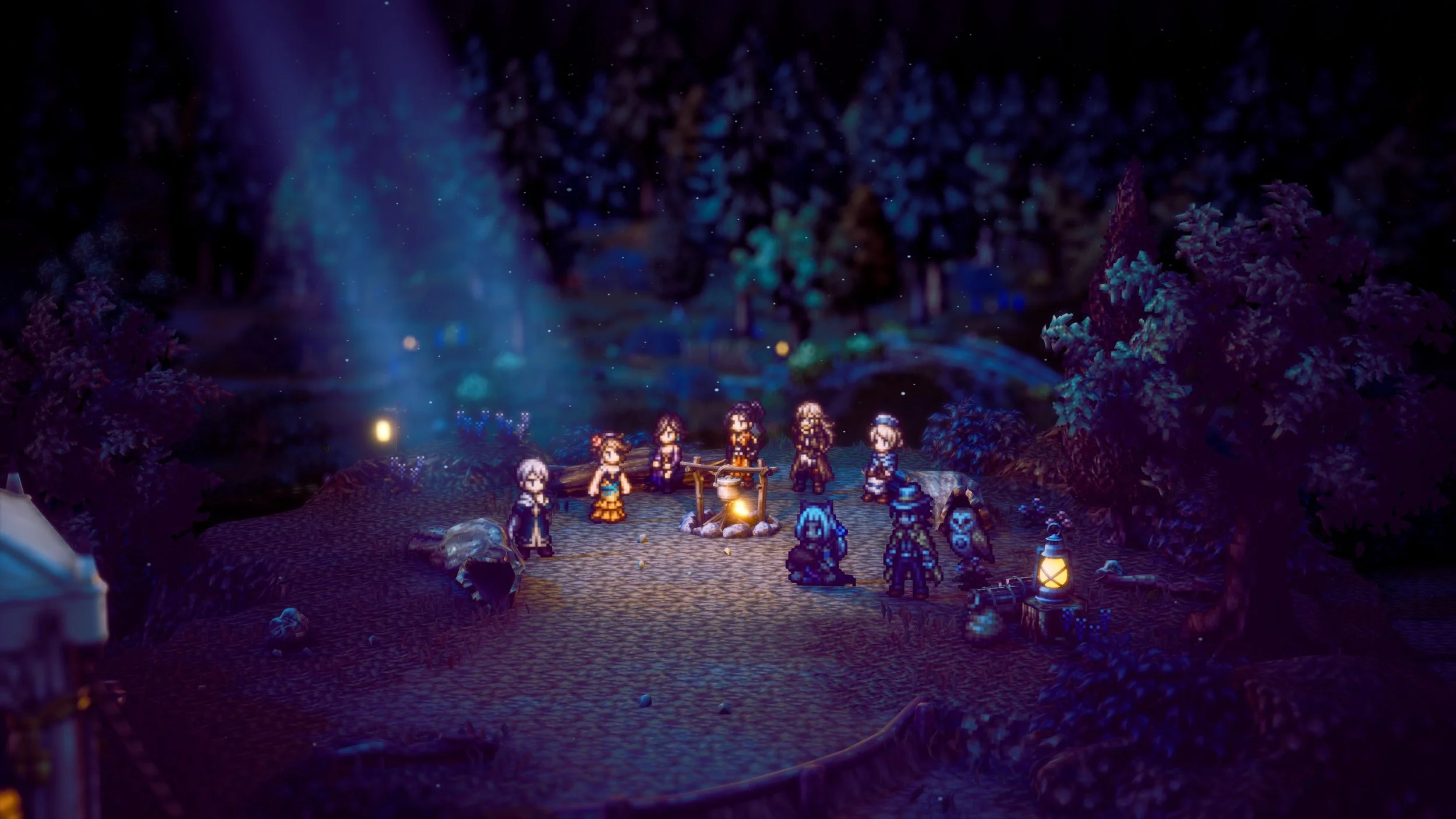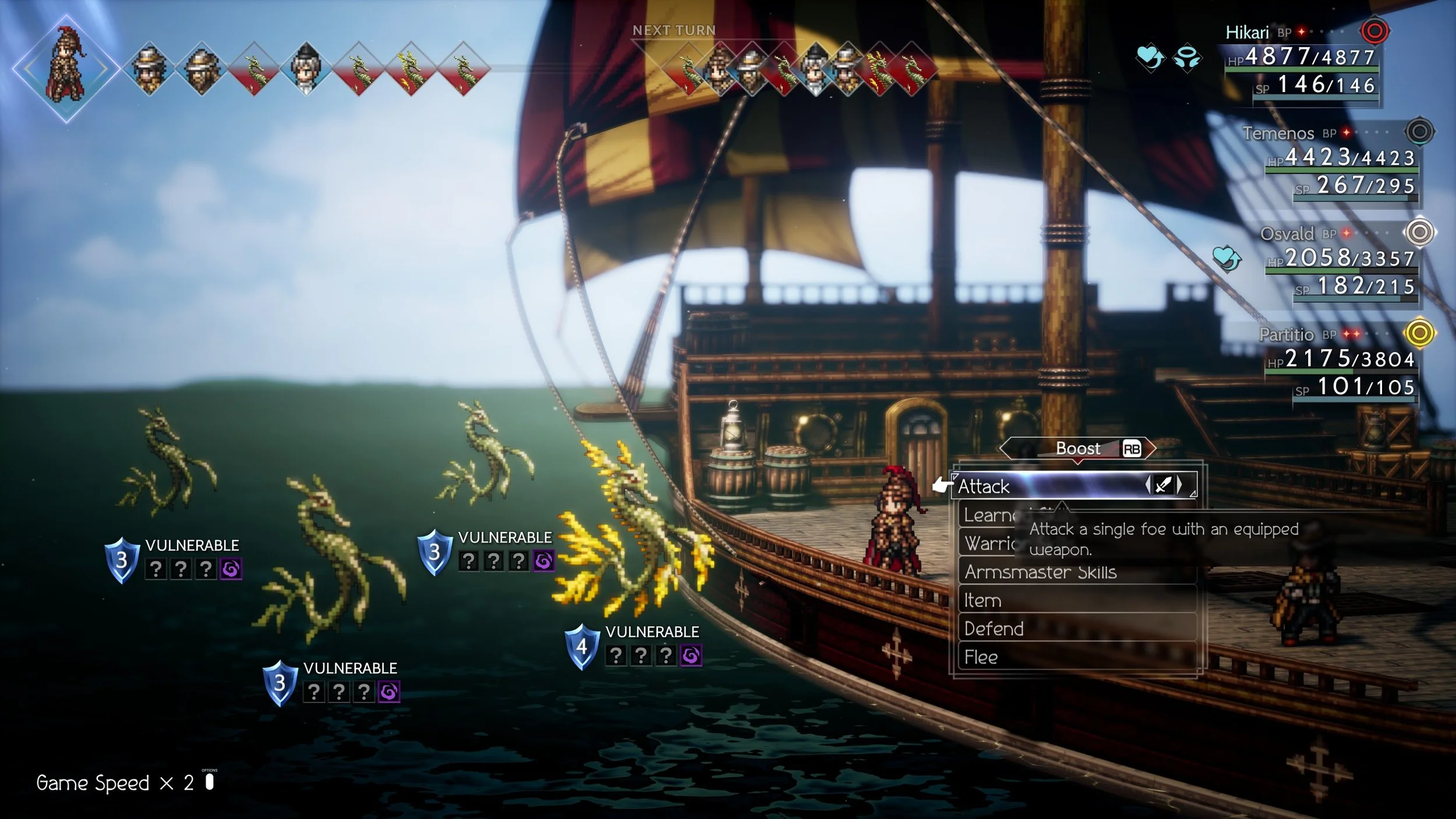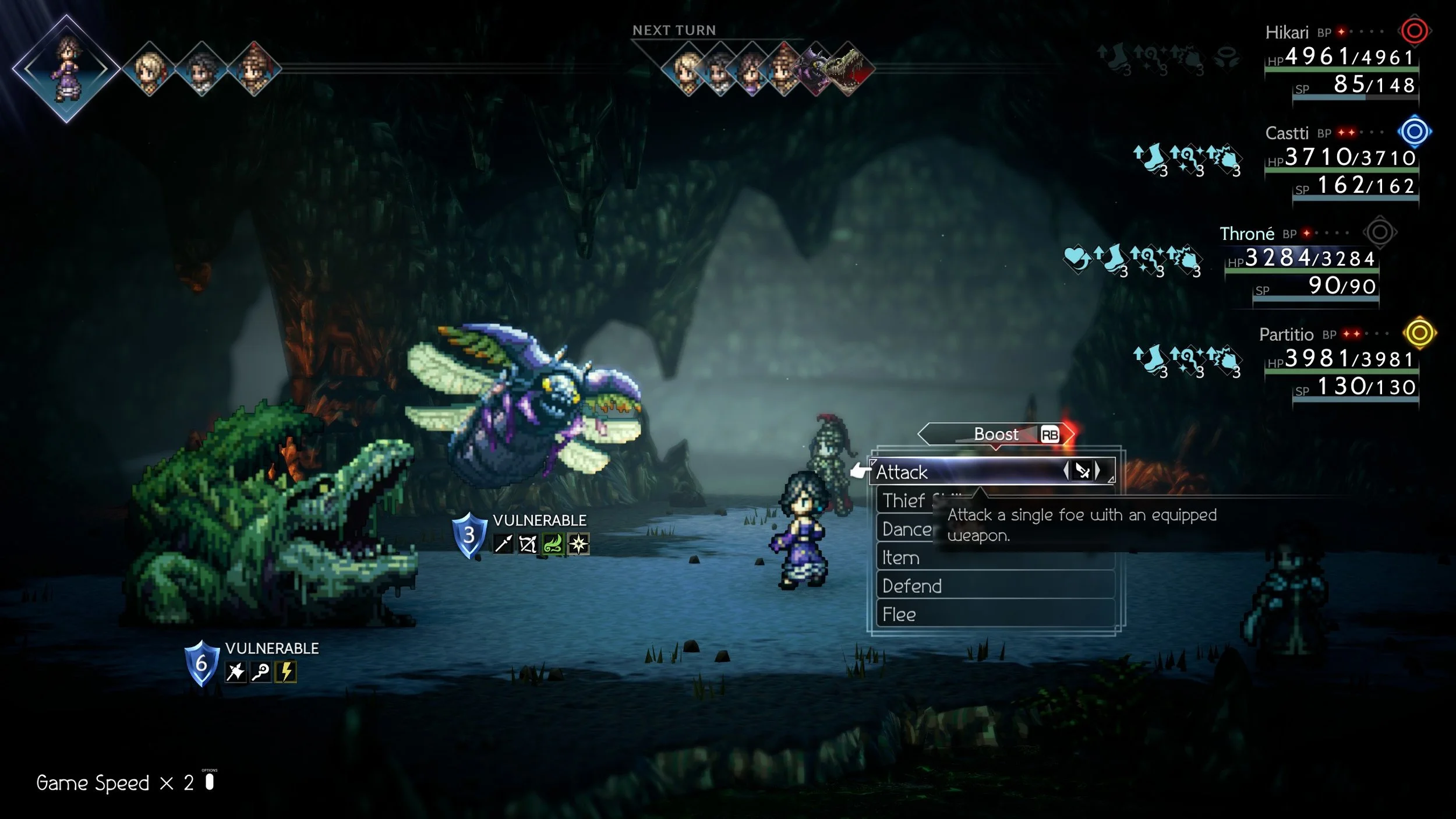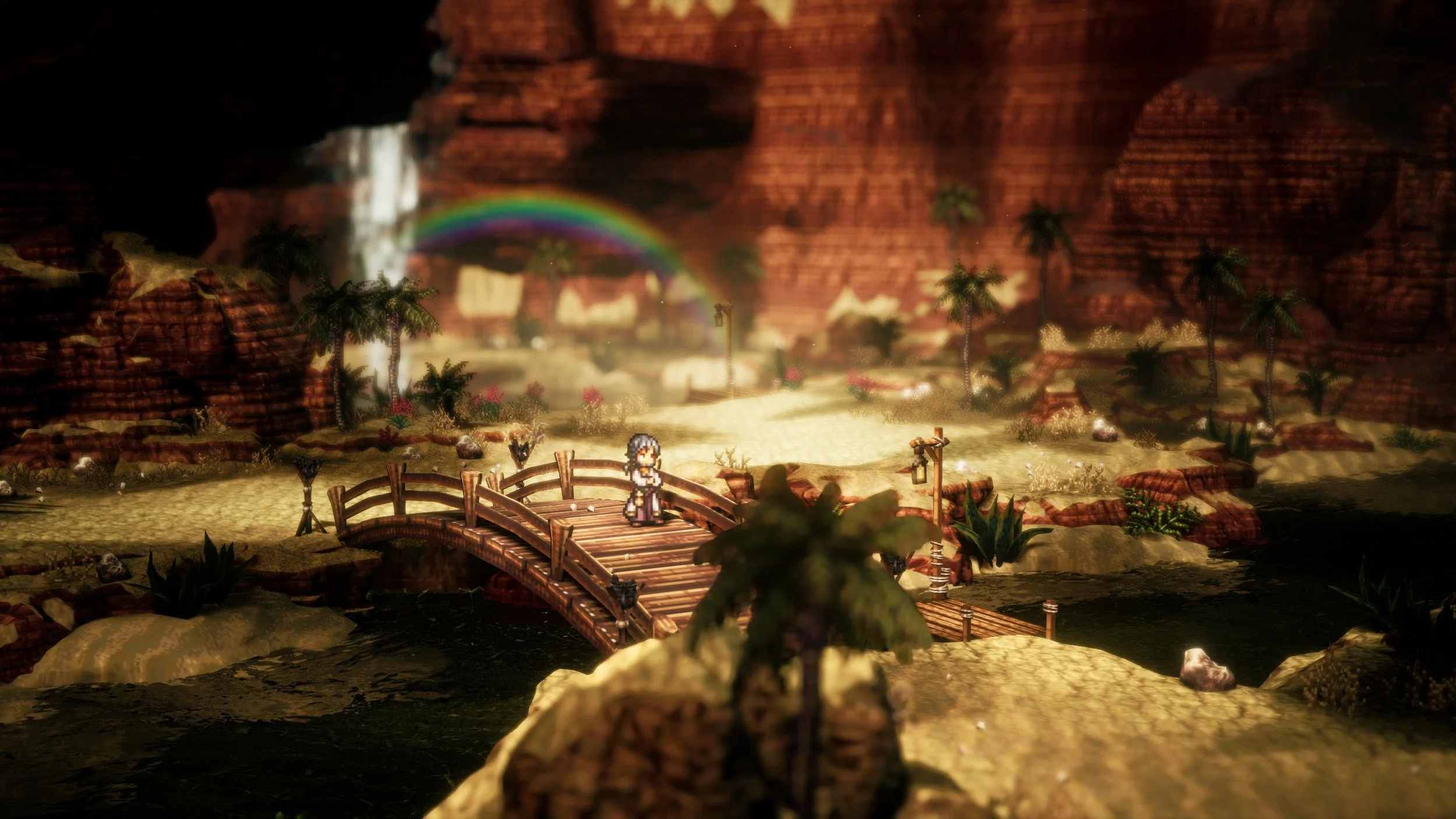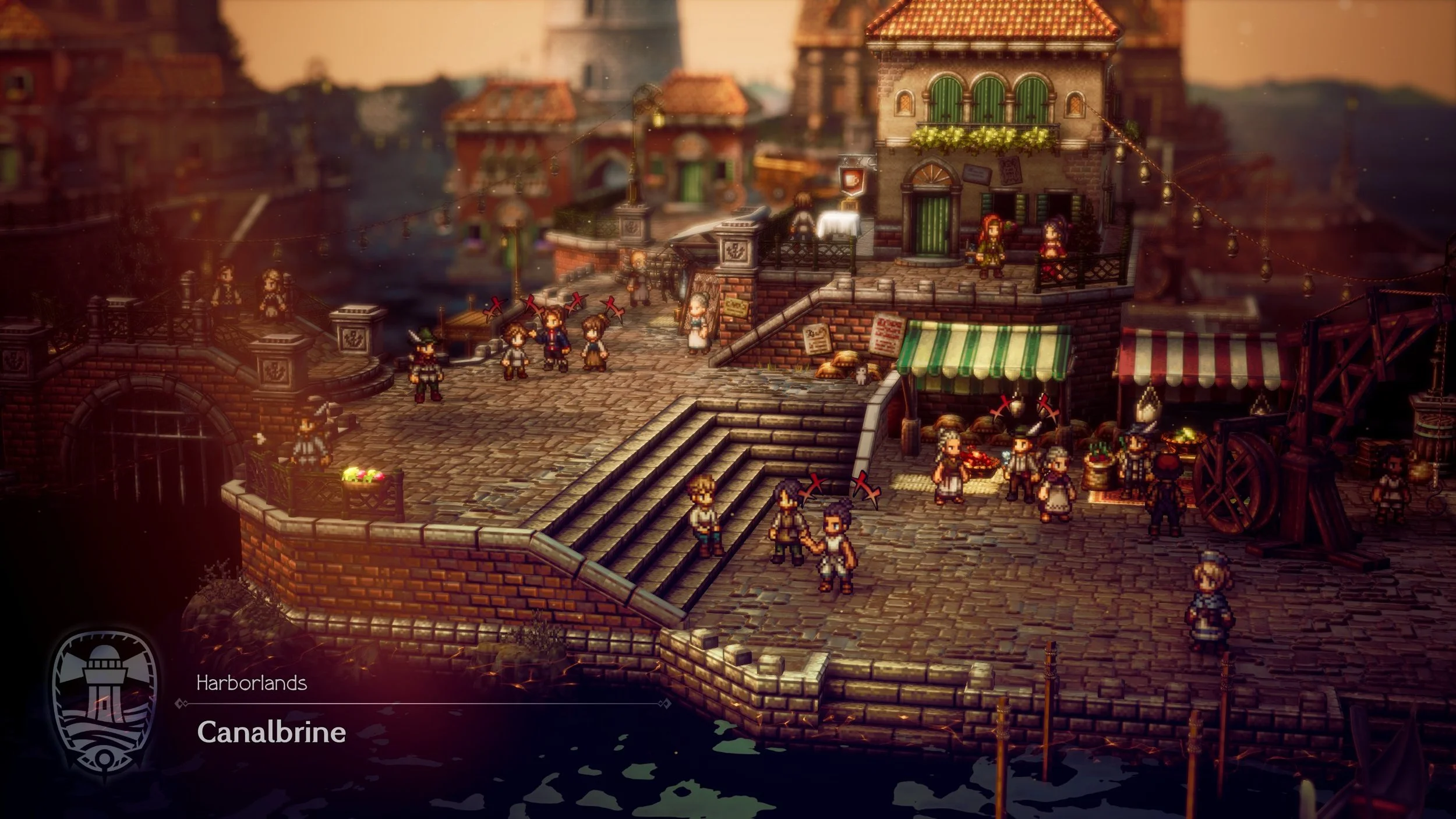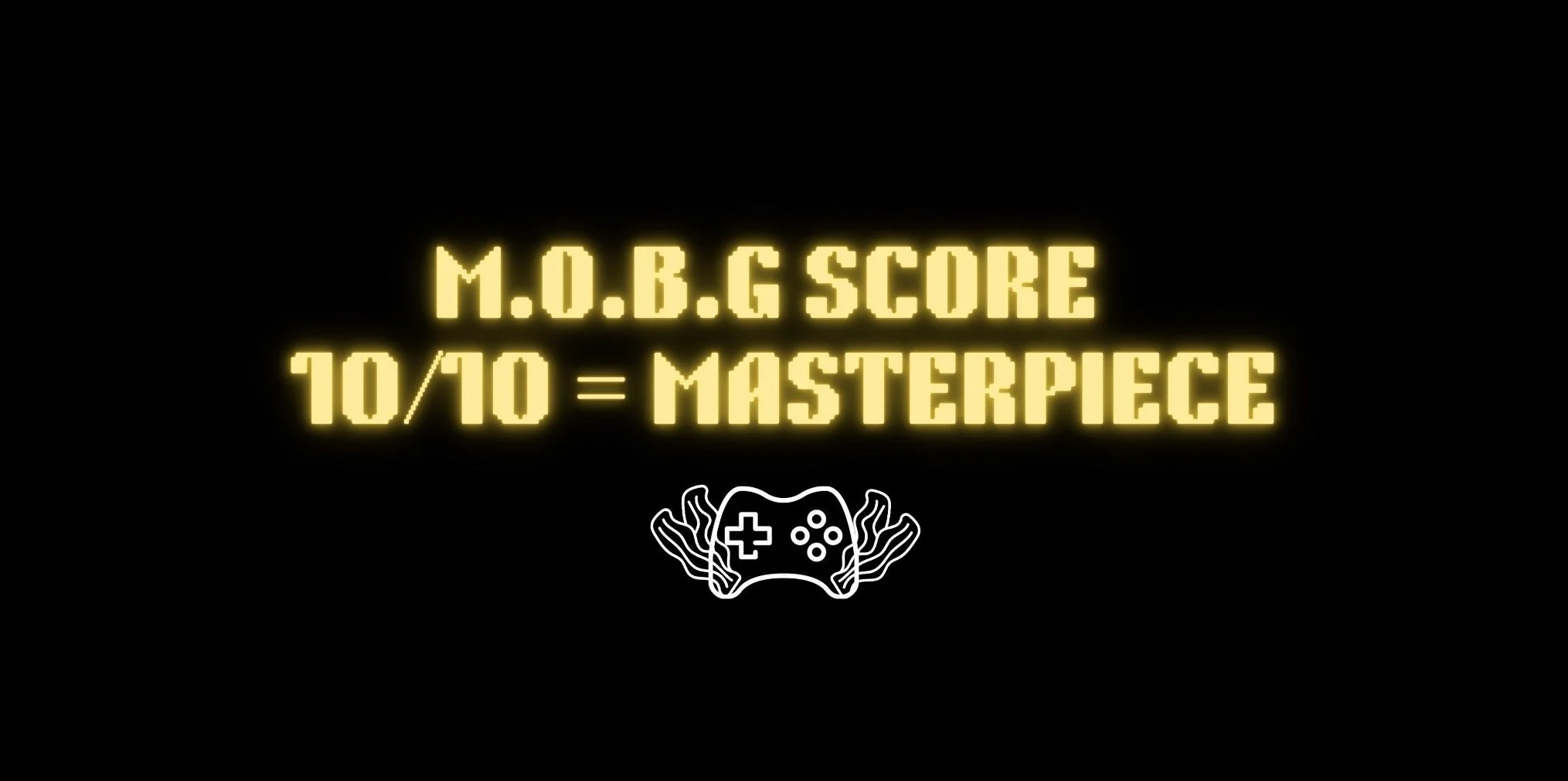Octopath traveler ii review - refining and elevating a hallmark jrpg experience
platform: pc
hours played: 90
Earlier this year, when I plucked Octopath Traveler from my backlog, I didn't expect it to be the all-consuming experience that it was, as its unique style of storytelling, flashy HD2D art style, and impressively deep turn-based combat system were unlike anything I had experienced. The turn-based JRPG floodgates had well and truly been opened, boasting a powerful current that would carry me straight into Octopath Traveler II. The sequel comes loaded with the elements I expected it to have, like the return of its hallmark storytelling approach, its striking HD2D art style, and more. However, supplementing these features are several additions to the formula that make it one of the most thoughtfully crafted sequels I've ever experienced. They fill the few cracks present in the first game's armor, while elevating the entire experience to unforgettable heights. Simply put, even though I spent roughly 90 hours in Octopath Traveler II, it took me just a handful of play sessions to recognize that this game is Square Enix's unique vision and formula perfectly realized into something truly remarkable.
Eight Stories and Beyond
I have a music playlist titled "The Greatest Video Game Tracks", which is a collection of my all-time favorite video game songs. On that list is a track titled Those Who Deny The Dawn, a song from Octopath Traveler II boasting an epic blend of heavy metal shredding and orchestral singing akin to what you would hear in Metaphor ReFantazio. Little did I know that "Those Who Deny The Dawn" would serve as the thematic through line tying the tales of all eight travelers together. In the first game, all eight stories stood independently of each other, and as a result, the party companionship that typically serves as the central story pillar in any JRPG was nonexistent. However, Octopath Traveler II features subtle but smart changes that go a long way to fixing this issue. From more in-depth travel banter that does a better job illustrating the relationships between travelers, to crossed paths – side quests that see the travelers paired up for short, yet intriguing adventures – there's a genuine sense of camaraderie that can be felt in a way that works for Octopath's unique formula.
In what feels like a direct response to the character disconnect staining the first game's otherwise remarkable formula, Octopath II features entire sections dedicated to bringing the entire party together. Without spoiling what happens, arriving at this part of the journey felt like Octopath II was settling into the traditional JRPG party formula, but in a way that feels cleverly tailored for this game's distinct storytelling approach. I felt chills when it happened, as seeing the party members actually talk to each other and reflect on each other's journeys felt like I was being handsomely rewarded as the player. After spending a combined 200 hours in both games, I have a deep appreciation for Acquire sticking with their unique storytelling style, while also finding creative and impactful ways to incorporate the traditional elements of the genre. Speaking of standing out, how about the stories themselves? Did any of them distinguish themselves from the rest?
Silver that Outshines Gold
One of the benefits of Octopath's storytelling formula is that it allows the game to feature a collection of wildly different tales, each boasting its own themes and settings that firmly set them up as truly individual experiences. What's more, with Octopath Traveler II bringing deeper, more dynamic storytelling to the table, the game gives the player an ever greater chance to find a story and a character that resonates with them. For example, Temenos' investigative tale that sees him uncovering the Church of the Sacred Flame's darkest secrets, propped up by his clever, anti-hero character qualities, felt like a more riveting, unpredictable adventure compared to Ophelia's much more straightforward tale of vengeance, supported by her overtly good-hearted nature. From Agnea's journey to becoming a dancing star, to Osvald's dark and gritty tale of revenge, and every tale in between, these stories all left me on the edge of my seat, each for its own unique reasons. Even knowing that each story is going to feature a twist or turn at some point, I never found myself getting tired of experiencing them. However, while I found my enjoyment of the game's overall story experience to be more even this time around, one story resonated with me more than the others. Enter Partitio, the Merchant.
In my mind, Octopath 1's most underwhelming tale was that of Tressa, the Merchant. Her journey of self-discovery often felt aimless, cookie-cutter, and devoid of any meaningful moments to hang its hat on, like the game's seven other tales. So, as a result, I was pretty soured on the Octopath's merchant storytelling -- a perhaps unfair judgment, given that the issues with Tressa's story had more to do with her character writing than it did with what it means to tell the story of a merchant. However, it didn't take long into Chapter 1 of Partitio's tale for his charisma, drive, and grit to jump off the screen and completely captivate me. Partitio hails from the town of Oresrush, a once-rich and bustling mining town that quickly sees its wealth ripped away owing to some nefarious deeds and an overall shift in the world's industrial trends. Seeing the impact that extreme financial hardship has on his town, Partito sets out on a journey to rid the world of poverty so that no one has to experience the struggles that he and his people did. It's Partitio's larger-than-life ambition, his witty southern charm, his relentless optimism, and remarkable resourcefulness that make him such a riveting character. Throughout his journey, I couldn't help but root for him at every turn and fist pump with excitement with every steam-engine-sized obstacle he somehow overcame.
The moment in Partitio's story that stood out to me the most, and perhaps the defining moment of his tale, came when he fearlessly signed a contract to obtain the rights for the steam engine for the mouth-watering sum of 80 billion leaves. When presented with the required cost, Partitio doesn't flinch. He doesn't try to alter the deal. He doesn't use the opportunity to enact revenge on Mr. Roque for plunging his hometown into crippling poverty. Instead, he stands tall on his morals and takes Mr. Roque to task by agreeing to this seemingly impossible deal. Partitio doesn't worry about how he'll acquire the leaves, as he has enough trust in his masterful skills as a merchant to get it done, and that confidence jumps through the screen and right into the heart of the player. The potential of bringing the power of the steam engine to people worldwide is what captures his mind and drives his ambition, and you just can't help but root for the guy. Walking away from Octopath II, I can't help but want to emulate Partitio's fearless spirit in my own life, and that is the true mark of an effectively written character.
Solistia - Pushing the Boundaries of World-Design
When Partitio meets the energetic scrivener during chapter two of his tale, she attempts to give him her business card so that they can keep in touch for her future headlines. Partito remarks that people back on the western continent don't have use for those; instead, they use silver as their calling card. In his ever-so-charismatic nature, Partitio then flips the scrivener a silver coin and tells her to keep it. Confused by the gesture, the scrivener responds by saying that people on the eastern continent have moved on from silver. This subtle exchange is actually rather significant, as it paints the picture of a vast, sprawling world divided not only by east and west, but by customs and traditions. Opening the game's map will further reveal a huge ocean separating the two sides of the continent, solidifying the massive scale of the game's world. What's more, is that you can actually traverse the sea using a ship docked at one of the game's three ports, providing a hands-on way to contend with Octopath II's massive scale.
Towns and cities have also been improved, as they're each packed with more detail and personality than ever before. New Delsta was perhaps my favorite -- boasting a dichotomy of a glamorous top-side full of fancy shops and upperclass townsfolk, and an underbelly section that feels like looking into the party from the outside without being allowed in. From upscale cities to mining outposts, church towns, and everything in between, Ocotpath Traveler II's depth of location variety is absolutely stunning. Perhaps the most significant improvement comes with the newly implemented waterways that you and your party can traverse on small boats. These waterways offer the player more nooks and crannies to explore, as well as a host of new aquatic-based enemies to battle. Extending to the open world, the waterways can lead to hidden dungeons or even serve as the only pathway leading to a new area.
Combat - Tooling Up For Victory
As the series that essentially got me into turn-based combat, I was pretty excited to get more of it in Octopath II. It then came as a welcome surprise then, that Octopath II's combat system came loaded with subtle but impactful balancing paired with smart additions that give you the tools for success without giving you an "I win" button. Firstly, abilities have been balanced so as not to allow the player to become overpowered too easily. For example, in the first game, stacking Cyrus' scholar ability stacked with the sorcerer subclass could turn him into an unstoppable magic damage dealer. However, in the sequel, magic abilities have been more evenly distributed, and must be more strategically considered when going into a fight. For example, Osvald cannot deal light damage unless he's given the cleric subclass, or wind damage unless he's given the dancer subclass -- a configuration that will drastically alter his combat composition depending on what you choose. Additionally, the divine subclasses have been reworked to act as a strategic support option, rather than the unstoppable trump cards they acted as in the first game.
The most impactful addition to the combat system lies with the latent abilities – powerful moves that can be triggered once your latent power gauge has been filled. From ultra-powerful physical damage attacks like Hikari's Sougetsusen attack, to Agnea's "All together now" ability, which allows her to share her augments with the entire party at once, each latent ability is cleverly crafted and tailored to the strengths of the character that wields them, and can easily turn the tide of battle if used at the right time. For example, during the final boss battle, I frequently used Partitio's "Hoot and Holler" latent ability to fill his BP meter in one turn, allowing me to activate a fully powered-up version of "hired help" to deal massive damage to all parts of the enemy as quickly as possible. In that same battle, I would use Castti's "Every Drop Counts" latent ability to concoct life-saving potions for the party without using up resources. Octopath Traveler II is a challenging game to conquer, but with latent abilities, you can turn the tide in your favor if you take the time to approach each battle with a strategy.
Visuals and Music
Octopath's stunning HD2D art style is what made it a standout visual experience from the get-go, and the sequel only takes that splendor to greater heights. The foundation of this visual approach remains the same. Realistic-looking waterfalls gracing the backdrop of a pixelated bridge, or the shining sands of the Ku desert set against 2D structures, still create the distinct visual experience the series is known for. However, subtle touches have been added to the sequel to make the experience more immersive. A host of the game's cutscenes feature more dynamic camera angles, adding visual depth to dialogue scenes. Special moves now feature more dynamic animations, like Hikari's Lionheart Axe ability, which sees him jump into the air to bring down a stunning amount of force upon his target. Activating latent abilities delivers a special animation that sees the camera angle shift behind the player to provide an exciting perspective as they act out their powerful move. These touches are subtle, but they elevate the game to an immersive experience that feels exciting to behold.
Long before I played Octopath Traveler II for the first time, I was listening to the game's soundtrack created by returning composer Yasunori Nishiki. From the heart-pumping main menu theme to thoughtful tracks crafted to capture tender moments of emotion, Yasunori's original score is breathtaking at every turn. However, Yasunori wasn't just tasked with creating a soundtrack that could follow the masterpiece that was the original game's song list, but also with creating renditions of each track that would complement the game's day and night cycles. No matter where you are in the world, whether it be a town, an open-world area, or anywhere in between, cycling between day and night will queue in a rendition of that area's track specific to the time of day you've chosen. Where daytime tracks are generally more energetic and spritely, their nighttime counterparts are scaled back, stripped down, and more intimate. The way each of these tracks brilliantly brings to life the atmosphere of the game's day and night cycle speaks to Yasunori's versatility and mastery as a composer, and I'm only sad that I'll never be able to hear his work for the first time again.
The Verdict
Octopath Traveler was a nearly perfect game. So, it stands to reason that I struggled to visualize how Octopath Traveler II could take that experience and make it better in a significant way that didn't feel like the developers were resting on their laurels. As it turns out, the sequel is better in every way. From subtle but meaningful changes like the 2x speed option for battles that makes grinding feel like a significantly less arduous task than it did in the first game, to day and night cycles that provide specific battle bonuses depending on the time of day you are engaging in combat and everything in between, I genuinely struggle to find anything I don't like about this game. It's a game I would proudly recommend to veterans of the genre and newcomers alike, and one I wish I could roll back the clock to experience for the first time again. Thankfully, there's more to come this winter when Octopath Traveler 0 bursts onto the scene, but for now, I'll happily reflect on Octopath Traveler II as the masterpiece that it is.


